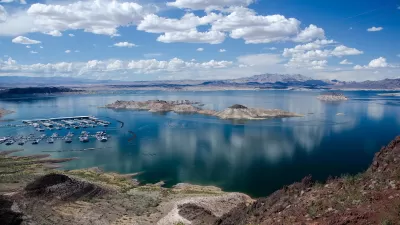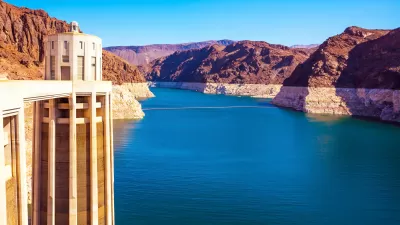In Nevada, efforts to conserve water include a ban on ornamental grass and regulations on swimming pool sizes.

Nevada and other Western states face another round of water restrictions as the water level in major reservoirs along the Colorado River continues to fall to historic lows.
As Jennifer Solis explains in the Nevada Current, “Water in Lake Mead is projected to fall below 1,075 feet in 2025, an elevation that would trigger a water shortage, according to a 24-month study by the Bureau of Reclamation.” The reservoir is currently at 37 percent capacity, threatening its ability to deliver water or produce hydroelectric power.
“States in both the lower and upper Colorado River basin are each allocated 7.5 million acre-feet of water, for a total of 15 million acre-feet. But officials acknowledge only 12.4 million acre-feet flows from the river each year, and flows continue to shrink due to climate change.” Solis notes that Nevada has not been using its full annual water allocation thanks to recent conservation efforts that include a ban on ornamental grass in many public spaces and limits on the size of swimming pools. “The Southern Nevada Water Authority managed to reduce individual water use to 89 gallons per person per day last year, the lowest since the early 1990s. But hotter, drier conditions this summer means water use per person is likely to increase this year.”
The Bureau of Reclamation expects that Lake Mead’s water level could fall far enough to trigger a Tier 2 shortage and deeper cuts by the end of 2025.
FULL STORY: Another year of water cuts for lower Colorado River Basin states, feds say

Alabama: Trump Terminates Settlements for Black Communities Harmed By Raw Sewage
Trump deemed the landmark civil rights agreement “illegal DEI and environmental justice policy.”

Study: Maui’s Plan to Convert Vacation Rentals to Long-Term Housing Could Cause Nearly $1 Billion Economic Loss
The plan would reduce visitor accommodation by 25% resulting in 1,900 jobs lost.

Why Should We Subsidize Public Transportation?
Many public transit agencies face financial stress due to rising costs, declining fare revenue, and declining subsidies. Transit advocates must provide a strong business case for increasing public transit funding.

Wind Energy on the Rise Despite Federal Policy Reversal
The Trump administration is revoking federal support for renewable energy, but demand for new projects continues unabated.

Passengers Flock to Caltrain After Electrification
The new electric trains are running faster and more reliably, leading to strong ridership growth on the Bay Area rail system.

Texas Churches Rally Behind ‘Yes in God’s Back Yard’ Legislation
Religious leaders want the state to reduce zoning regulations to streamline leasing church-owned land to housing developers.
Urban Design for Planners 1: Software Tools
This six-course series explores essential urban design concepts using open source software and equips planners with the tools they need to participate fully in the urban design process.
Planning for Universal Design
Learn the tools for implementing Universal Design in planning regulations.
Caltrans
Smith Gee Studio
Institute for Housing and Urban Development Studies (IHS)
City of Grandview
Harvard GSD Executive Education
Toledo-Lucas County Plan Commissions
Salt Lake City
NYU Wagner Graduate School of Public Service





























